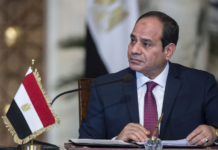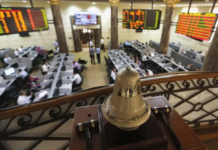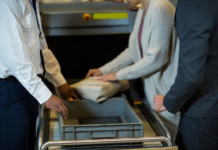In an atmosphere of celebration, the first trial operation of the transit of cargo ships through the New Suez Canal went off without a hitch. Lt. Gen. Mohab Mamish, chairman of the Suez Canal Authority; Maj. Gen. Kamal al-Wazir, chief of staff of the Engineering Authority of the Armed Forces; and senior army commanders, officials and project staff were all present to watch this historic event.
Convoys of international cargo ships transited the two channels of the Suez Canal, one old and one new. They sailed in separate groups to ensure that the new canal was safe ahead of the official opening on 6 August.
Afterwards Mamish announced that the success of the trial operation involving vessels of various sizes confirmed the safety of the waterway, sending a message of reassurance to the world and a response to sceptics.
Maj. Gen. Abbas Kamal, director of the office of President Abdel-Fattah El-Sisi, visited Ismailia and met Mamish and Yasin Tahir, the Ismailia governor, to check on preparations for receiving the guests and their accommodation.
An official source said that 10 guidance stations were in place along the old and new waterways and were fitted with screens to monitor the transit time of vessels and meteorological devices to identify the movement of tides and wind speed and direction and link them to the main centres for guidance in Ismailia, Port Said and Suez. The first phase of the project has been completed, according to the source. Seventy buoys have been set up on the new canal, and by this week all the buoys in the waterway will be in place.
The source said new lists for ship navigation of the canal were being printed. New electronic maps have been made, since modifications were needed to show all the specifications for the deepening and expansion of the current canal, in addition to the new canal. The source stressed that the water section of the new canal was identical to the old canal.
Tugs and launches with accompanying guides are being readied to meet the requirements of the simultaneous crossing of the north- and southbound convoys in the central sector of the canal at Ismailia. Guides for transiting the new canal were trained at the the Suez Canal Authority’s maritime and simulation training centre.
In terms of development of the dredging work, all deepening and expansion of 72 kms of the western branches of the Great Lakes is finished, making it the first sector of this project to be completed. This was carried out by the Belgian-US Hope consortium using 31dredgers. The last four dredgers on the site are finalising the work and will soon leave the area.
Dredging of 53 kms of the new Suez Canal was completed using 62 dredgers belonging to the Challenge consortium led by the UAE company, which included the Dutch Van Oord and Boskalis companies and the Belgian Jean O’Donnell Company.
Implementation rates included the completion of the targeted deepening and expansion of the western branch of al-Ballah for 10 kms using six dredgers belonging to the Suez Canal Authority.
Details of the opening ceremony
It has been a race against time to prepare for the opening ceremony on 6 August, which will be witnessed by the eminent guests, including heads of state, invited by President Sisi.
The ceremony is supervised by an Egyptian-French-American consortium. Replicas of the pyramids, the Sphinx and a pharaonic obelisk have been placed on the bank of the canal, and commemorative plaques are erected on both sides of the opening ceremony stage and on each bank of the new canal.
It was suggested that 50 cargo ships from 50 countries perform folkloric shows representing the cultures of these countries, and 40 ships sound their horns in conjunction with the opening ceremony. Maj. Gen. Wazir, who as Chief of Staff of the Engineering Authority is the overall supervisor, says tomorrow’s ceremony will take place east and west of the canal, but all in the Ismailia area.
The ceremony will include events taking place for the first time to offer the gift of Egypt to the world, as the canal will serve world trade. The ceremony area will include a main stage east of the canal and three presidential stages, in front of which will hang murals depicting the history of the digging of the old and the new canals. The murals will carry the names of the companies and engineers who supervised the project, including the dredging companies, and will be no higher than six metres so as not to obstruct views of the canal.
The Chief of Staff of the Engineering Authority says the opening of the Suez Canal will be a day to make a difference in the history of Egypt. It will witness the participation of all shades of Egyptian society. Several major stages will overlook the waterway, and runways will receive the presidential delegations while quays will receive those coming by boat from the old canal to the new, as well as visitors arriving by air in Ismailia and Cairo and then travelling overland to the event. A ceremony will be organised on the eastern shore of the new channel, in addition to the night festivities which will be attended by a large number of artists.
A statue representing an Egyptian female peasant has been erected behind the obelisk. It has two wings in the form of the wings of an eagle, the symbol on Egypt’s flag. Two statues of the Sphinx recline on the right and left to guard Egypt, alongside an ancient Egyptian peasant, a labourer and a contemporary soldier.
Wazir says that the location for the main stage was chosen because it was directly in front of the 1,700-metre channel connecting the two canals at the point where the Empress Eugenie, the guest of honour, witnessed the original opening in 1869. Those sitting on the main stage will see everything on the old and new canals, as well as the connecting canal, and will see the ships sailing past on the old canal towards Suez.
French aid was enlisted in the planning and design stage only, while the murals, monuments and other effects were implemented by the Egyptian military museums department using Egyptian materials and by Egyptian officers and engineers, who took museum courses before creating the October War Panorama with the aid of Korean experts.
The committee charged with supervising the celebrations was headed by Mohab Mamish, the Suez Canal Authority chairman; the general director of the moral affairs department of the Armed Forces; and several officials of the presidency, the Suez Canal Authority and Egyptian media and television.
It is expected that President Sisi will enter the new Suez Canal at Km. 86, where a special aircraft landing pad is in place. The President will then sail along the new canal on board the historic al-Mahrousa yacht. The 150-year-old yacht has been used by Egyptian heads of state and resembles a floating palace with holdings of pure gold.
A source said the engineering department of the Armed Forces had been busy finalising renovation of the Social Club in New Ismailia City to receive heads of state. A luncheon will be served in the ballroom. The Engineering Department has completed the construction of the theatre which is scheduled to witness the opening ceremony New Suez Canal at Km. 78, on the east side of the canal.
Film director Magdy al-Hawari is making a documentary about the opening of the new Suez Canal, and a team has been filming the dredging and the project staff. The first 45-minute film depicts the drilling of the Suez Canal and will be broadcast on Egyptian television and satellite TV channels.
The Suez Canal Authority is publishing a book documenting work on the project from the idea and design stage to completion. It will be printed in several languages and be distributed to guests at the opening ceremony. Commemorative coins will also be issued for the occasion, and the Suez Canal Authority is preparing a list of the names of those who worked on the project in their honour.
Mamish says 5,000 people will attend the opening ceremony, among them Russian President Vladimir Putin and French President Francois Hollande. President Sisi wanted to have all categories of Egyptian people represented, particularly young people, to witness this national achievement that adds a new bright page to the nation’s history.
Statistics and figures
Statistics indicate 250 million cubic metres of dry drilling of the main canal for 53 kms from the Km. 60 sign on the channel to the north to the Km. 95 sign on the canal to the south, in addition to communication channels at the 65 km., Km. 76, Km. 84 and Km. 89 signs for four kilometres with a total of 180 million cubic metres of dry drilling.
The drilling of 70 million cubic metres to expand the Ballah branch has been completed for 10 kms and widened by 61 metres to 312 metres. Additional work includes bridges and ferries and the unloading of sedimentation basins in the main channel, the deepening and expansion of natural lakes in the new Ismailia City and the underwater drilling.
In cooperation with the Suez Canal Authority, dredging began a month after the launch of the project to deepen the new Suez Canal for 53 kms and increase the depth and width of the west branch of Ballah Island for 10 kms, the Deversoir and Kabreet branches for 72 kms, and four communication channels of the new channel with a total of 250 million cubic metres of underwater drilling.
To transfer and secure facilities—telecommunications, electricity, water, fuel and irrigation water—and pass them underneath the new Suez Canal, 30 syphons secure the intersection of the railroad from Fardan to Bir al-Abd on the new Suez Canal path. All the other natural gas pipelines at intersections have also been secured.
Development of roads east of the canal was carried out in accordance with three priorities. First, the expansion of the road from al-Salaam bridge to Sarabium and the linking of Fardan, al-Awsat and Sarabium have been completed for 5.25 km. Second, the sand bridge is being eliminated, and creation and development of roads linking the crossings to a total length of 180 kms is currently being implemented. Third, the Ismailia to Awja road is being expanded, giving a total length of 211 kms.
Ismailia celebrating
Ismailia Governor Maj. Gen. Yasin Tahir says work has continued daily and a state of emergency has been declared at all facilities and local units in the province. Roads, squares and the entrance to the governorate have been renovated and decorated in readiness for the large number of guests expected at the opening ceremony, in addition to guests of the presidency from abroad. Intensive preparations were carried out to receive guests and provide facilities in coordination with the Suez Canal Authority and the governorate in terms of maintaining parks and public squares, particularly those overlooking the Suez Canal such as the Malaha and No. 6 parks.
Tahir added that the squares in Ismailia would celebrate in tandem with the main ceremony. Artists have erected statues and sculptures at the entrances to the governorate.
With safety and security an issue, the governor highlighted the coordination of the armed forces and the Interior Ministry fully to secure the opening ceremony and the governorate by monitoring roads and farms and checking all visitors. The army is securing all entrances to the governorate, and patrols are roaming the streets.















